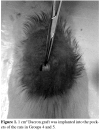The antibacterial effect of mesenchymThe antibacterial effect of mesenchymal stem cells on graft infections: An experimental studyal stem cells on graft infections: An experimental study
- PMID: 32082799
- PMCID: PMC7018195
- DOI: 10.5606/tgkdc.dergisi.2018.16049
The antibacterial effect of mesenchymThe antibacterial effect of mesenchymal stem cells on graft infections: An experimental studyal stem cells on graft infections: An experimental study
Abstract
Background: In this study, we aimed to investigate the antibacterial effects of mesenchymal stem cells, compared to tigecycline, on graft infection related with methicillin-resistant Staphylococcus epidermidis in a rat model.
Methods: A total of 42 male adult Wistar rats (age >6 months; weight 300 to 350 g) were divided into six groups including seven rats in each. Group 0 did not undergo any procedure; Group 1 was infected, but untreated; Group 2 was infected and treated with tigecycline without graft placement; Group 3 was infected and received mesenchymal stem cells without graft placement; Group 4 was infected and treated with tigecycline after graft placement; Group 5 was infected and treated with mesenchymal stem cells after graft placement. The pockets created were either left empty or implanted with Dacron grafts. Treatment was commenced at 48 h. Specimens were collected on Day 13. Perigraft tissues were evaluated histopathologically and bacterial colony numbers were counted.
Results: No bacterial colonization was observed in Group 0, whereas there was a significant colonization in Group 1. Complete eradication was achieved in Group 2 and Group 3 (graft-free groups), and near-complete eradication was achieved in Group 4 and Group 5 (graft-implanted groups). The histopathological findings significantly differed between Group 1-Group 2 and between Group 1-Group 3 (graft-free groups). The histopathological findings were similar between Group 2-Group 3 and between Group 4-Group 5.
Conclusion: Our study results suggest that mesenchymal stem cells may be a novel, contemporary alternative to antibiotherapy and may decrease the bio-burden of Staphylococcus at the infected graft areas, and mesenchymal stem cell treatment may be as effective as tigecycline.
Keywords: Infection; Staphylococcus epidermidis; mesenchymal stem cell; tigecycline; wound.
Copyright © 2018, Turkish Society of Cardiovascular Surgery.
Conflict of interest statement
Conflict of Interest: The authors declared no conflicts of interest with respect to the authorship and/or publication of this article.
Figures




Similar articles
-
Mesenchymal stem cells have significant anti-infective effect on methicillin-resistant Staphylococcus epidermidis vascular graft infections.Eklem Hastalik Cerrahisi. 2019 Dec;30(3):201-11. doi: 10.5606/ehc.2019.66162. Eklem Hastalik Cerrahisi. 2019. PMID: 31650915
-
Linezolid compared with vancomycin for the prevention of methicillin-resistant Staphylococcus aureus or Staphylococcus epidermidis vascular graft infection in rats: A randomized, controlled, experimental study.Curr Ther Res Clin Exp. 2007 Jan;68(1):23-31. doi: 10.1016/j.curtheres.2007.02.001. Curr Ther Res Clin Exp. 2007. PMID: 24678116 Free PMC article.
-
Does in situ replacement of a staphylococcal infected vascular graft with a rifampicin impregnated gelatin sealed Dacron graft reduce the incidence of subsequent infection?Int Angiol. 1999 Sep;18(3):225-32. Int Angiol. 1999. PMID: 10688422
-
Synergistic antibacterial effect of co-administering adipose-derived mesenchymal stromal cells and Ophiophagus hannah L-amino acid oxidase in a mouse model of methicillin-resistant Staphylococcus aureus-infected wounds.Stem Cell Res Ther. 2017 Jan 23;8(1):5. doi: 10.1186/s13287-016-0457-2. Stem Cell Res Ther. 2017. PMID: 28114965 Free PMC article.
-
Temporin A as a prophylactic agent against methicillin sodium-susceptible and methicillin sodium-resistant Staphylococcus epidermidis vascular graft infection.J Vasc Surg. 2002 Nov;36(5):1027-30. doi: 10.1067/mva.2002.127530. J Vasc Surg. 2002. PMID: 12422090
References
-
- Yang SY, Strong N, Gong X, Heggeness MH. Differentiation of nerve-derived adult pluripotent stem cells into osteoblastic and endothelial cells. Spine J. 2017;17:277–281. - PubMed
-
- Bakre MM, Hoi A, Mong JC, Koh YY, Wong KY, Stanton LW. Generation of multipotential mesendodermal progenitors from mouse embryonic stem cells via sustained Wnt pathway activation. Biol Chem. 2007;282:31703–31712. - PubMed
LinkOut - more resources
Full Text Sources
